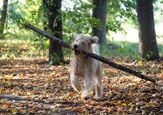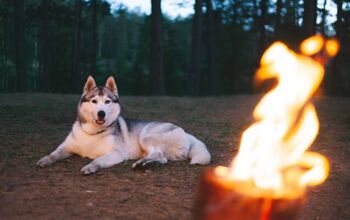How a Safe Space Can Reduce Your Dog's Anxiety

Have you ever noticed your dog pacing, panting, or hiding during thunderstorms or fireworks? Does your dog panic when a new guest arrives? You’re not alone! Many dogs experience anxiety, and it can have a significant impact on their well-being. Anxiety has been associated with higher stress levels, behavioral changes, and even physical health issues. Understanding how to ease your pup’s anxiety is key to providing the best possible quality of life.
While there are calming products and supplements you can try, they often serve as a temporary solution to a more long-term problem. Creating a safe space is a proactive approach that can empower your dog to manage their stress and feel secure in their own home.
Understanding Your Dog’s Anxiety
Just like people, dogs can experience anxiety, and it can stem from a variety of triggers. Some of the most common culprits include:
- Loud Noises: fear and anxiety triggered by loud sounds such as thunder, fireworks, or construction
- Separation Anxiety: the distress dogs feel when they are left alone
- Social Anxiety: stress and anxiety triggered by interactions with people (especially strangers) or other animals
- Travel Anxiety: increased stress often associated with car rides or vet visits
While these are the most common causes, your dog’s anxiety could be caused by just about anything that causes them stress or upset. Even subtle changes in routine or environment and past traumatic experiences can manifest in anxiety. With such a wide range of possible triggers, it’s easy to see why it’s so common.
Recognizing the symptoms of anxiety is the first step in providing trimly support and much-needed relief. These signs can be physical, behavioral, or a combination of both. You may notice your dog is panting excessively, pacing, trembling, or whining. Many anxious dogs will also hide or seek constant reassurance from their people. Some dogs will even display destructive behavior, like digging and chewing. Subtle cues like lip licking, yawning, and “whale eye” (showing the whites of their eyes) are also signs of underlying fear and anxiety.
Not only is anxiety an uncomfortable situation in the moment, but chronic or prolonged anxiety can lead to a long list of health problems and a diminished quality of life.
When dogs experience stress, their bodies release hormones like cortisol, which, over time, can weaken the immune system, upset their sleep patterns, and contribute to gastrointestinal problems. Chronic stress can also worsen existing health issues and negatively impact their overall mental and emotional well-being. This is why it is so important to take steps to address the problem if you suspect your dog is struggling with anxiety. It’s not just about relieving their immediate discomfort; it’s about protecting their long-term health and happiness.
What is a Safe Space?
A safe space for your dog is a designated area or room where they can retreat to feel secure and protected. It’s their refuge from the stressors of daily life, a place where they can find comfort and calm if they are feeling overwhelmed. Think of it as their personal sanctuary, a place they can go when they need to decompress and feel safe.
Think of the average teen or pre-teen child and the importance of their bedroom. When they are feeling angry, upset, or frustrated with anything happening at school or home, that’s the space they usually run to (often accompanied by slamming the door). This is the equivalent for your pup.
Your dog’s safe space could be a quiet corner of a room, a rarely used room like a guest room, den, or even their crate.
One common misconception is that creating a safe space is a form of punishing or isolating your dog. This couldn’t be further from the truth. This special area shouldn’t be seen as a punishment. It’s a positive and comforting retreat. A safe space is a tool to empower your dog to manage their anxiety, not to confine them. In fact, more often than not, their ability to move about the house isn’t restricted in any way. Instead, it's a place where they can voluntarily seek comfort, a haven where they can feel secure and protected.
Of course, to make this feel like a safe place they can turn to, there are a few factors you will need to consider, including the actual setup of the space and the training required to help create a positive association with it. So, let’s look at those two key elements in more detail…
Creating the Ideal Safe Space
To set up the ideal safe space for your dog, you must carefully consider several factors, from location and comfort to gradual introduction and positive reinforcement. The following guidelines will help you provide your pup with a secure and calming getaway.
Location, Location, Location
When setting up your dog’s space, location is key. Consider your dog’s personality and preferences. Some dogs will feel safer in a space that is closer to their person, while others would be happier tucked away somewhere secluded on their own. Ideal spots are often quiet corners, back rooms, or even closets. The goal is to find a naturally secluded area away from your home’s highest-traffic zones.
Your dog may prefer enclosed spaces with a door or flap that cuts them off from the rest of the world. Alternatively, they may feel more comfortable in an open area. Pay attention to your dog’s natural hiding spots for clues as to what will make them feel most secure.
The Right Bed or Crate
A comfortable bed or crate should be the central feature of this safe space. Size, material, and placement are all factors to consider. The bed or crate should allow your dog to stand up, turn around, and lie down comfortably. Consider whether soft, plush materials or a firm, supportive surface best suits your dog’s preferences.
If you’re using a crate to build out this space, you’ll need to choose between a more open or closed crate design. Open crates offer security while allowing your dog to still see what’s going on around them. Closed crates create a more secluded spot. If you currently have an open crate but feel your dog would benefit from a closed design, you can easily transform it with a crate cover or even just a blanket draped over the top.
Calming Elements
Once you have decided on the location and basic structure of your pup’s safe space, you can now consider ways to enhance the space area with comforting items. Soft blankets and pillows make the space feel cozy while adding familiar smells. Meanwhile, your dog’s favorite toys and chew items provide mental stimulation, which can be soothing during times of stress.
Here are a few other options you may incorporate to make the space even more secure and comfortable:
- Clothing with your scent can also offer a feeling of security. Use a t-shirt or sweater that you have worn a bit instead of something freshly washed so it genuinely smells like you.
- White noise machines or calming music can help to hide any distracting sounds.
- Diffusers with dog-safe essential oils, like lavender or chamomile, can promote relaxation. But use them cautiously and after thorough research to keep your pup safe.
- Pheromone products, like sprays or diffusers, mimic dog-appeasing pheromones to help reduce stress and anxiety.
Gradual Introduction and Positive Association
When the space is set up, gradually introduce it to your dog while using positive reinforcement. Never force your dog inside. If they are reluctant to go in, try scattering some treats inside as extra motivation. When they do enter, praise and reward them. As they become more comfortable, gradually increase the time they spend there – especially if it involves closing a crate door or safety gate.
You can also create positive associations with this space by feeding their meals in the area or giving them their favorite toys or chews inside. This helps them to view it as a positive space where good things come their way.
Make it a “No-Stress Zone”
Moving forward, ensure that this space remains free from punishment or negative experiences. Never use it as a place to put your dog on a “time out.” Explain to your family members (especially children) to respect your dog’s privacy when they are inside. Avoid disturbing them or forcing them to leave if they have chosen to retreat there.
Avoid too much noise or activity near your pet’s space when possible. By maintaining a calm environment, you help to reinforce that it is a safe space your dog can view as a sanctuary.
Training and Management Tips
Introducing your dog to their safe space is crucial, but there are even more steps you can take to use training to help address your pup’s anxiety. Here are a few tips to help make your dog feel safe and secure in their daily routine:
Teaching the “Go to Your Safe Space” Command
Teaching your dog a command like “Go to your safe space” is a valuable tool. While the space should be available for your dog to retreat to if they feel it’s necessary, there are times when you may identify a trigger before it escalates that far. Sending your dog to this quiet, comforting location can help prevent their anxiety from escalating.
As your dog enters their space, clearly say your chosen command and reward them immediately. Repeat this regularly, increasing the distance you give the command from. For example, you may start directly beside the space, 2 feet away, then across the room. Consistency and patience are vital.
Recognizing When to Encourage Safe Space Use
Identifying a potential trigger is a great time to use this space. For example, if you know your dog experiences stress and anxiety when someone new comes into the home, and you have a friend visiting, you can get ahead of it. But that isn’t the only time to use their safe space.
Familiarize yourself with the early signs of anxiety, such as panting, pacing, or trembling. If you notice any of these signs, gently guide your dog to their safe space using a calm tone. Avoid forcing them, but encourage them with gentle nudges or treats. If you have already taught the command, this is an ideal time to use it.
Managing Anxiety in Specific Situations
If you know a situation is coming that will trigger anxiety, such as a thunderstorm or fireworks, prepare the safe space with calming elements in advance. This could include using a pheromone spray or turning on some calming music. When introducing new people or pets to your dog, allow them to retreat to their safe pace if they feel overwhelmed. Make sure visitors or other pets leave them alone when they are there. This will let them adjust to these new arrivals at their own pace.
When traveling, bring familiar items from the space to create a mini safe space. Some easier-to-transport items include:
- A blanket or plush toy from their safe space with their scent
- Their favorite calming music that you play when they are in their space
- Familiar scents, like your go-to essential oils
When to Seek Professional Help
If your dog’s anxiety is severe or persistent, having a safe space may not be enough. In these situations, it is best to seek help from a veterinarian or a certified dog behaviorist. They can identify the causes of your dog’s anxiety and recommend treatment options like medication or behavior modification. Professional guidance is a sign of responsible pet parenting.
Improve Your Dog’s Quality of Life with a Safe Space
Creating a safe space for your dog is a powerful tool for managing their anxiety and improving their overall well-being. By providing them with a designated area where they can feel secure and protected, you offer them a much-needed refuge from any stress triggers.
A safe space is not a comfortable corner; it’s a proactive step towards a happier, healthier life for your best friend. By prioritizing their comfort and well-being, you strengthen your bond and create a home environment where your dog feels safe and secure.
Join the PetGuide community. Get the latest pet news and product recommendations by subscribing to our newsletter here.

Britt Kascjak is a proud pet mom, sharing her heart (and her home) with her “pack” which includes her husband John, their 2 dogs – Lucifer and Willow – and their 3 cats – Pippen, Jinx, and Theia. She has been active in the animal rescue community for over 15 years, volunteering, fostering and advocating for organizations across Canada and the US. In her free time, she enjoys traveling around the country camping, hiking, and canoeing with her pets.
More by Britt
























